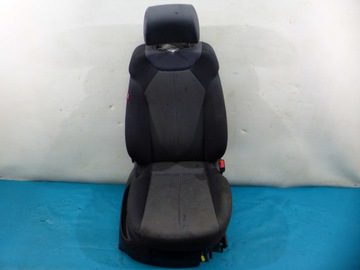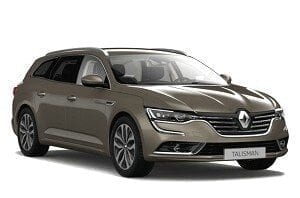
Seat Leon 2.0 TFSI Stylance
The Seat Leon itself looks like an interesting and beautiful car. It is also a good choice with mid-range engines, the brand itself is close to the hearts of many people, and in addition to its shape, Leon is also distinguished by its user-friendliness, which can satisfy a wide range of people. Families too. His biggest problem is that when people think of him, they always think of his ("cousin") Golf. And through no fault of their own. Leon has many competitors, and although he is (technically) quite close to Gough, his real, most direct competitors are others, starting with the Alfa 147.
Ever since Seat was owned by VAG, their cars have been portrayed as hot-tempered, temperamental. It would be difficult to claim all of these, but if we had to list them, we would certainly put this first place: 2.0 TFSI. The powerplant is hidden behind the label: a two-liter direct injection gasoline engine and a turbocharger.
That said, we are faced with a dilemma: if the seats are more temperamental than Volkswagens, why does a Golf with the same engine configuration have about 11 kilowatts (15 hp) (and 10 Newton meters) more? Undoubtedly the answer is that such a Golf is called a GTI, and the Golf GTI “has to” maintain its image. But on the other hand, it should be emphasized right away: since enough is enough, no more is needed. I am, of course, talking about engine power.
In a direct performance comparison, the Golf GTI takes on the Leon TFSI, although the latter is slightly lighter, these seconds are only counted on paper and on the racetrack. Feelings in everyday traffic and on normal roads are important. Without thinking about the competition, the Leon TFSI proves to be top-notch: friendly to the undemanding and obedient to the demanding. With no fear of being pushed into your first closed garage by the average family member, you can think soberly, and if you enjoy turning the steering wheel, you can expect exactly what the tech and numbers promise: sporty, almost racing. Spark. ...
Inadvertently, the comparison with the 2.0 TDI engine with torque is forced, which in itself makes a very good, even slightly sporty impression. But here's what Leon reminds us once again: no turbodiesel can please a gasoline turbo engine, neither by the sound of the engine, nor by the range of speeds used. It's only when you try it, switching from one to the other, that you really feel the huge difference and understand what a top-notch, truly enjoyable sports engine means.
Leon already possesses some genetic perfection: an overhead driving position, a straight (high) mounted and upright steering wheel, excellent seats with very good lateral grip, a great information system and a central (though not the biggest) rev counter. In such a car it is always pleasant to sit and drive, independently of a friend.
Add to that the pedals that the Golf should envy, as they deserve a clean A: for the right stiffness, for the right stroke (remember the clutch stroke in Volkswagen!) and – perhaps most importantly – for sporty momentum – for the accelerator pedal installed from below. It's unlikely that Seats will have different gearboxes than Volkswagens, but in this case, Leonov seems to be better-behaved, with length, stiffness, and shifter feedback, and shifting speed he can handle.
Except, perhaps, the Leon color, it does not arouse much curiosity, as, for example, the Golf GTI. This is why he is generous to the driver: no matter the pace of the ride, he is easy to control, but when necessary, he easily shows many a simple twin tailpipe. You can do this on the highway, where you are driving on the speedometer at 210 kilometers per hour and a half throttle in sixth gear, but you need to be very patient for the next 20. However, four aces keep the Leon TFSI behind the road where the turns follow one to others, and if the road still rises noticeably, such a Leon becomes a device for pure pleasure. And to annoy everyone in the name (and performance) of a lot more sports cars.
In terms of technology, driving pleasure in general and the overall configuration, the price of such a Leon does not even seem particularly high, and the tax falls on gas stations. At 5.000 rpm in sixth gear, it moves at a speed of about 200 kilometers per hour, but then the on-board computer shows an average of 18 liters of gasoline per 100 kilometers and two more liters at 220 kilometers per hour. Anyone tempted by racing-style mountain roads can count on a fuel consumption of 17 liters per 100 kilometers, and even the most moderate driving will not reduce thirst noticeably below 10 liters for the normal length of the route.
But for the pleasures it offers, consumption does not seem tragic either; more than in the case of (test) Leon, he is bothered by the loud rubbing of hard plastic around the sensors or the closing of the tailgate, for which a special procedure must be invented. Or – who doesn't get more exuberant – blink the driver's right elbow into the high seat belt buckle.
It may also be alarming that in the front compartment there is no lock, no interior lighting, or the possibility of cooling. But it's all the legacy of a car called the Leon, and if you're not quite picky it shouldn't really affect your decision to buy a Leon TFSI. However, this Leon has everything you'd expect from a car at this price, and maybe even more.
The almost completely (sporty) black interior sounds gloomy in theory, but on the seats and partly on the door trim, it is simply imperceptibly woven with red thread, which, coupled with the pleasant interior design, breaks the uniformity. If any particular flaw in the Leon TFSI needs to be found by force, it could be sensors, among which one should really expect one that measures oil (temperature, pressure) or pressure in a turbocharger. So many things and nothing more.
So, once again on luck: both in terms of design and technology, this Leon seems to be very lucky, as he, among other things, combines the highest performance with ease of driving. Believe me, there are fewer such machines.
Vinko Kernc
Photo: Vinko Kernc, Aleš Pavletič
Seat Leon 2.0 TFSI Stylance
Basic data
| Sales: | Porsche Slovenia |
|---|---|
| Base model price: | 21.619,93 € |
| Test model cost: | 22.533,80 € |
| Calculate the cost of auto insurance | |
| Power: | 136kW (185 KM) |
| Acceleration (0-100 km / h): | 7,8 with |
| Maximum speed: | 221 km / h |
| Mixed flow ECE: | 8,1l / 100km |
Technical information
| engine: | 4-cylinder - 4-stroke - in-line - turbo-petrol with direct fuel injection - displacement 1984 cm3 - maximum power 136 kW (185 hp) at 6000 rpm - maximum torque 270 Nm at 1800-5000 rpm / min. |
|---|---|
| Energy transfer: | front wheel drive engine - 6-speed manual transmission - tires 225/45 R 17 Y (Bridgestone Potenza RE050). |
| Capacity: | top speed 221 km / h - acceleration 0-100 km / h in 7,8 s - fuel consumption (ECE) 11,2 / 6,4 / 8,1 l / 100 km. |
| Mass: | empty vehicle 1334 kg - permissible gross weight 1904 kg. |
| External dimensions: | length 4315 mm - width 1768 mm - height 1458 mm. |
| Inner dimensions: | fuel tank 55 l. |
| Box: | 341 |
Our measurements
| T = 13 ° C / p = 1003 mbar / rel. Ownership: 83% / Condition, km meter: 4879 km | |
| Acceleration 0-100km: | 7,7s |
|---|---|
| 402m from the city: | 15,6 years ( 150 km / h) |
| 1000m from the city: | 28,0 years ( 189 km / h) |
| Flexibility 50-90km / h: | 5,5 / 7,3s |
| Flexibility 80-120km / h: | 7,1 / 13,2s |
| Maximum speed: | 221km / h (WE.) |
| test consumption: | 13,8 l / 100km |
| Braking distance at 100 km / h: | 37,1m |
| AM table: | 40m |
evaluation
If we were rated for pleasure, I would get a clean five. The best is yet to come: despite its excellent performance, the Leon TFSI is light and easy to drive. Also note that the rest of the Leon is a five-door utility family car...
We praise and reproach
engine
Transmission
driving position
inside
capacity
driver friendliness
seat
cricket in the meter
closing the trunk lid
the buckle of the seat belt is too high
the front passenger compartment is not illuminated
consumption
